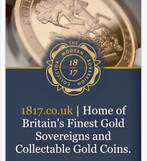Sovereigns of William IV dates types mintages varieties and rarity scales.
William IV (1830 - 1837)
Born: 21 Aug 1765
Accession: 26 Jun 1830
Married: Adelaide of Saxe-Coburg and Meiningen
Coronation: 8 Sep 1831
Children: 2
Died: 20 Jun 1837 (71)
Accession: 26 Jun 1830
Married: Adelaide of Saxe-Coburg and Meiningen
Coronation: 8 Sep 1831
Children: 2
Died: 20 Jun 1837 (71)
Sell Sovereigns
We buy all modern gold sovereigns, from collectors, traders, investors and others.
The standard design for the currency Sovereigns of King William IV from 1830-1837 inclusive was engraved by William Wyon after Francis Chantrey’s model, and consists of two bare headed bust types and one standard reverse. Both bust types have the same legend.
The first bust obverse has more finely engraved hair most noticeable on the top of his head and a more rounded ear. The position of the bust in relation to the legend dictates that his nose points to the second letter N in BRITANNIAR. The first bust obverse has border teeth that are quite fine and tall, and more in number when compared with obverse two.
The second obverse has coarser hair, a flat top to the ear and the nose points to the second I in BRITANNIAR. The border teeth also differ from the first bust as the obverse teeth are of a coarser wide spread rendering, with less depth. The majority of the coinage of William IV Sovereigns, depict this obverse, including the very first pattern piece of 1830. It seems the demarcation of second bust relates really to its use ending with the reign in 1837, as the first bust type finishes first by 1832. The reverse teeth on the second bust obverse coins are similar to the first bust obverse ones, and are taller and finer than those on the obverse of the second bust coins.
The reverses of William IV engraved by Jean Baptiste Merlen, always carry eight strings in the Irish harp with a diagonal line running through them depicting the rear of the bottom harp body. The inner arches of the crown above have thirteen pearls on each side, and five more run diagonally up each side of the central upright. There are nine varied jewels on the crown band. There is a short legend reading to the lower left anno and the date to the lower right. The edges are milled as usual.
The first bust obverse has more finely engraved hair most noticeable on the top of his head and a more rounded ear. The position of the bust in relation to the legend dictates that his nose points to the second letter N in BRITANNIAR. The first bust obverse has border teeth that are quite fine and tall, and more in number when compared with obverse two.
The second obverse has coarser hair, a flat top to the ear and the nose points to the second I in BRITANNIAR. The border teeth also differ from the first bust as the obverse teeth are of a coarser wide spread rendering, with less depth. The majority of the coinage of William IV Sovereigns, depict this obverse, including the very first pattern piece of 1830. It seems the demarcation of second bust relates really to its use ending with the reign in 1837, as the first bust type finishes first by 1832. The reverse teeth on the second bust obverse coins are similar to the first bust obverse ones, and are taller and finer than those on the obverse of the second bust coins.
The reverses of William IV engraved by Jean Baptiste Merlen, always carry eight strings in the Irish harp with a diagonal line running through them depicting the rear of the bottom harp body. The inner arches of the crown above have thirteen pearls on each side, and five more run diagonally up each side of the central upright. There are nine varied jewels on the crown band. There is a short legend reading to the lower left anno and the date to the lower right. The edges are milled as usual.
William IV Bare Head Sovereigns
|
|
|
|
|
|
|


